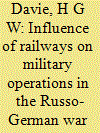| Srl | Item |
| 1 |
ID:
153500


|
|
|
|
|
| Summary/Abstract |
In common with much of the historiography of the Russo-German War of 1941–1945, there has been extensive study of the role of railways in the war, with either side concentrating on different aspects of the subject. But to date there has been little attempt to make a comparative study of the railways on both sides and to gauge the effect of differences in capacity on military operations and their outcomes. This lack has allowed one or both sides to obscure key failures and to deflect the influence on military operations away from railways. Yet the ubiquitous nature of railways for travel and transport in Russia, due to the large size of the country and the inability of motor vehicles to support operations beyond 300–400 km, meant that every military operation of the war was dependant on railways, and the way in which they were used was a key element in their success or failure. The current study aims to compare operating practices between Soviet and German military railways, to give estimates of the railway capacity available to both sides, and then to use this information to gauge the effect of this capacity on military operations.
|
|
|
|
|
|
|
|
|
|
|
|
|
|
|
|
| 2 |
ID:
162703


|
|
|
|
|
| Summary/Abstract |
Motor vehicles have always been regarded as an indicator of modernity, technological advancement, and industrial progress, right from the time of the first motor car in 1885. The Soviet Union was no exception, and there is an extensive Soviet historiography of the development of motor transport and its use during the German-Soviet War. The aim of this article is to put the wartime military and economic use of Soviet vehicles into a wider context, highlighting how mechanization was not the only important variable in successful logistics. The case study here will be the role of transportation in the logistics of a Soviet combined arms army (общевойсковая армия) utilizing detailed primary source material from the pamyat-naroda.ru website.
|
|
|
|
|
|
|
|
|
|
|
|
|
|
|
|
| 3 |
ID:
179765


|
|
|
|
|
| Summary/Abstract |
This article sets out to examine the inner working of combined-arms armies logistics over the course of the war through the use of a series of seven reports contained within the ‘Collection of Materials on the Experience of War’ and comparing these assessments with statistics from archival documents on two actual operations, Operation Polkovodets Rumyantsev in August 1943 and the Vistula-Oder Operation in January 1945. These results show that combined-arms armies gained their operational mobility from rapid re-establishment of railways and a carefully choreographed use of a small motor vehicle fleet, coupled with strict adherence to weight limits and living off the land by combat troops and their horse-drawn transport. This achievement of high mobility using limited means was a unique approach particularly tailored to the Red Army’s force structure and the Soviet Union’s available economic support.
|
|
|
|
|
|
|
|
|
|
|
|
|
|
|
|
| 4 |
ID:
175647


|
|
|
|
|
| Summary/Abstract |
Soviet tank armies used a form of logistics different from that of Western armies that specifically allowed them a high degree of mobility and the ability to operate deeply behind enemy lines without fear of interruption. The buildup for offensives was provided by railways, and the offensives themselves were time limited, awaiting the arrival of the field armies and restored railway connections. Nonetheless, when used as part of a series of offensives, these long-range penetrations acted to break up the German defenses. The reason for choosing the Uman–Botoșani Operation for this study is that according to Soviet historiography, it represented the first occasion in which the ‘deep operation’ concept was successfully implemented.
|
|
|
|
|
|
|
|
|
|
|
|
|
|
|
|